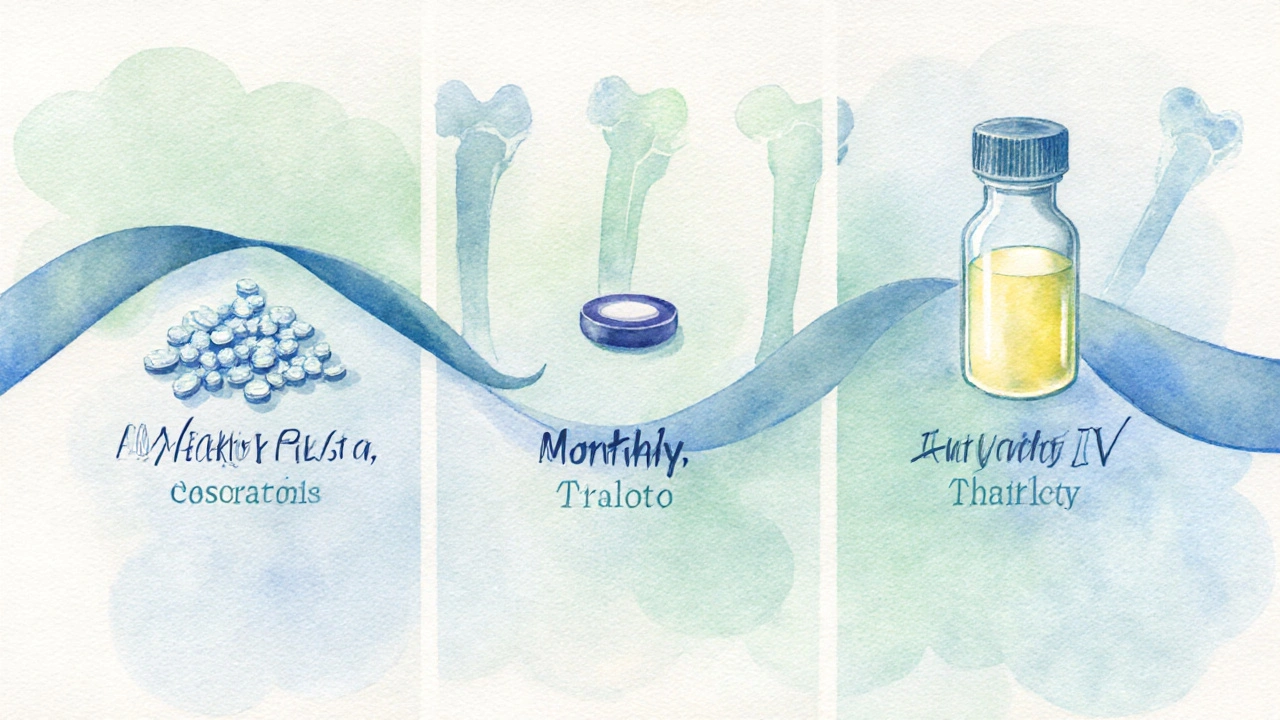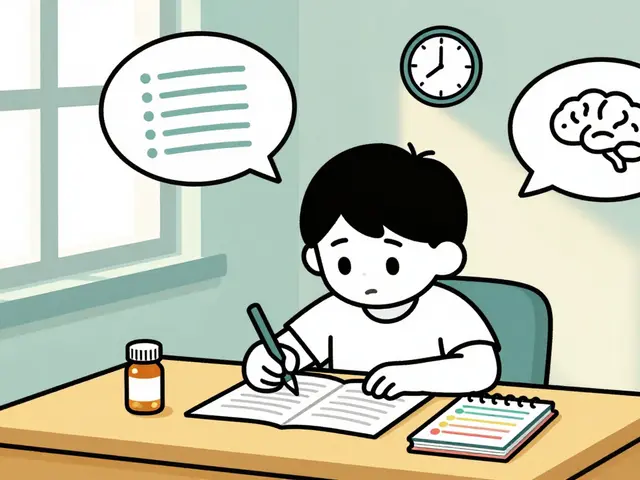
Osteoporosis Treatment Comparison Tool
Select your preferences to compare osteoporosis medications:
Quick Take
- Fosamax is a weekly oral bisphosphonate that reduces fracture risk by up to 45%.
- Alternatives include other bisphosphonates (Risedronate, Ibandronate, Zoledronic acid), a monoclonal antibody (Denosumab), and anabolic agents (Teriparatide, Romosozumab).
- Key decision factors: dosing convenience, side‑effect profile, kidney function, and cost.
- Patients with renal impairment often switch from oral bisphosphonates to Denosumab or annual IV options.
- Always pair medication with calcium and vitamin D for optimal bone health.
When a doctor mentions "bone‑strengthening pills," most people think of Fosamax (Alendronate), an oral bisphosphonate taken once a week. But the market now offers several other options, each with its own pros and cons. This guide walks through the most common alternatives, compares them on practical criteria, and helps you decide which drug-or combination-fits your lifestyle, health status, and budget.
Understanding the Core Players
Before diving into the side‑by‑side table, let’s define the main drugs you’ll encounter.
Fosamax is a nitrogen‑containing bisphosphonate that binds to bone surface and inhibits osteoclast‑mediated resorption. It was approved in 1995 and remains a first‑line oral therapy for post‑menopausal women and men with osteoporosis.
Risedronate works the same way as Alendronate but is available in daily, weekly, or monthly tablets, giving patients more dosing flexibility.
Ibandronate can be taken orally once a month or given intravenously every three months, making it a middle ground between daily pills and yearly infusions.
Zoledronic acid is a potent IV bisphosphonate administered once a year. Its high binding affinity means patients get a full year of protection from a single infusion.
Denosumab is a monoclonal antibody injected subcutaneously every six months. It works by blocking RANKL, a protein that tells osteoclasts to break down bone.
Teriparatide is a synthetic form of parathyroid hormone given as a daily subcutaneous injection. Unlike the anti‑resorptive drugs above, it actually stimulates new bone formation.
Romosozumab is a newer monoclonal antibody that both inhibits bone resorption and boosts formation, administered once a month for up to a year.
Finally, the two foundational supplements-Calcium and Vitamin D-are essential for any osteoporosis regimen because they provide the raw material and hormonal support needed for the drugs to work effectively.
Side‑by‑Side Comparison Table
| Drug | Class | Typical Administration | Dosing Frequency | Common Side Effects | Renal Considerations | Average Annual Cost (USD) |
|---|---|---|---|---|---|---|
| Fosamax (Alendronate) | Bisphosphonate | Oral tablet | Weekly | Esophageal irritation, flu‑like symptoms | Avoid if CrCl <30mL/min | ≈ $300 |
| Risedronate | Bisphosphonate | Oral tablet | Daily, weekly, or monthly | Stomach upset, musculoskeletal pain | Same as Fosamax | ≈ $350 |
| Ibandronate | Bisphosphonate | Oral tablet or IV infusion | Monthly (oral) / Every 3mo (IV) | Joint pain, fever, gastrointestinal irritation | Moderate - monitor if CrCl 30‑50mL/min | ≈ $400 |
| Zoledronic acid | Bisphosphonate | IV infusion | Yearly | Acute phase reaction, renal toxicity | Contraindicated if CrCl <35mL/min | ≈ $1,200 |
| Denosumab | RANKL inhibitor (monoclonal antibody) | Subcutaneous injection | Every 6months | Skin infection, hypocalcemia, rare osteonecrosis of jaw | Safe in renal impairment; monitor calcium | ≈ $2,500 |
| Teriparatide | Anabolic hormone analog | Subcutaneous injection | Daily | Nausea, leg cramps, hypercalcemia | Safe in most renal states; limit to 2years | ≈ $20,000 (2‑yr course) |
| Romosozumab | Sclerostin inhibitor | Subcutaneous injection | Monthly | Injection site reactions, cardiovascular alerts | No renal dose adjustment needed | ≈ $30,000 (1‑yr course) |
| Calcium + Vitamin D | Supplement | Oral tablets/capsules | Daily | Constipation (Ca), hypercalcemia (excess) | Generally safe; adjust in severe kidney disease | ≈ $100 |
How to Pick the Right Option for You
Choosing a therapy isn’t just about price tags. Below are the most common decision points you’ll discuss with your clinician.
- Dosing convenience. If you hate swallowing pills or have a busy schedule, a six‑month injection (Denosumab) or a once‑yearly IV (Zoledronic acid) may feel easier than remembering a weekly tablet.
- Gastro‑intestinal tolerance. Oral bisphosphonates require you to stay upright for 30‑60 minutes after taking them. People with reflux or esophageal disorders often switch to IV or subcutaneous options.
- Kidney function. The kidneys clear most bisphosphonates. If your creatinine clearance is below 30mL/min, doctors typically avoid oral and IV bisphosphonates and favor Denosumab.
- Fracture risk severity. Very high risk (multiple vertebral fractures) may justify an anabolic agent like Teriparatide or Romosozumab, even though they are pricey.
- Insurance coverage. Some health plans cover generic oral bisphosphonates but not the newer biologics. Check your formulary before committing.

Real‑World Scenarios
Case 1 - Busy professional with mild osteoporosis
Emma, 58, works long hours and forgets to take meds. Her doctor prescribed Denosumab because a single injection every six months fits her schedule. She also takes a calcium‑vitamin D supplement. After two years, her bone mineral density (BMD) improved by 8% and she reported no side effects.
Case 2 - Patient with chronic kidney disease
John, 72, has stage3 CKD (eGFR35mL/min). Because oral bisphosphonates could worsen his renal function, his endocrinologist chose Denosumab, monitoring calcium levels closely. He avoided the flu‑like reactions that often accompany IV bisphosphonates.
Case 3 - Severe vertebral fractures
Lina, 65, suffered three consecutive vertebral compression fractures. Her specialist started her on Teriparatide for 18 months to rebuild bone, then transitioned to Alendronate for maintenance. The combined approach led to a 12% BMD gain and no new fractures.
Potential Pitfalls and How to Avoid Them
Even the best drug can backfire if you ignore practical warnings.
- Missing doses. Skipping a weekly Alendronate tablet reduces its effectiveness dramatically. Set a reminder or pair the dose with a routine activity like brushing teeth.
- Not supplementing calcium/D. All anti‑resorptive medications assume you have enough calcium. Without supplements, the drug can’t bind to bone efficiently.
- Ignoring dental health. Some agents (especially high‑dose bisphosphonates and Denosumab) increase the rare risk of osteonecrosis of the jaw. Get a dental check‑up before starting and practice good oral hygiene.
- Stopping Denosumab abruptly. Discontinuation can cause a rebound increase in bone turnover, raising fracture risk. If you need to stop, transition to another agent under supervision.
Bottom Line: Tailor Treatment to Your Life
There’s no universal "best" osteoporosis drug. Fosamax remains a solid, cost‑effective choice for many, but alternatives can solve specific problems-whether it’s dosing convenience, kidney safety, or the need for rapid bone building. Talk openly with your healthcare provider about your medical history, lifestyle, and budget. The right decision is the one you can stick to consistently.
Frequently Asked Questions
Can I switch from Fosamax to another medication?
Yes. Switching is common when side effects arise, kidney function changes, or dosing convenience becomes a priority. Your doctor will usually implement a short “wash‑out” period before starting a new drug, especially when moving between bisphosphonates and denosumab.
How long should I stay on Fosamax?
Most guidelines suggest a “drug holiday” after 5‑10 years of continuous bisphosphonate use, provided bone density has stabilized. Your doctor will order a repeat DEXA scan to decide when a break is safe.
Is Denosumab safe for people with low calcium levels?
Denosumab can cause hypocalcemia, so physicians usually check calcium and vitamin D status before each injection. If you’re deficient, they’ll correct it with supplements before starting the drug.
What’s the difference between anabolic and anti‑resorptive therapies?
Anti‑resorptives (like Fosamax, Denosumab) slow down the breakdown of bone. Anabolics (like Teriparatide, Romosozumab) actively stimulate new bone formation. In severe cases, doctors may use an anabolic first, then follow with an anti‑resorptive to keep the gains.
Do I need a prescription for calcium and vitamin D?
Most over‑the‑counter supplements are fine without a prescription, but your doctor can recommend a specific dose based on blood tests. High‑dose vitamin D should only be taken under medical supervision.




8 Comments
Considering the dosing convenience, Fosamax’s weekly schedule does fit well into most adult routines.
Evidently, the pharmacodynamic profile of alendronate contributes to its sustained inhibition of osteoclast-mediated bone resorption, which is reflected in the reduction of vertebral fracture incidence reported in multiple randomized controlled trials. Moreover, the oral route simplifies adherence for patients who may have limited access to infusion facilities. Nonetheless, clinicians must counsel patients regarding the necessity of remaining upright for thirty minutes post‑dose to mitigate esophageal irritation. The comparative cost analysis reveals that while the annual expense of Fosamax remains modest relative to monoclonal antibodies, insurance formularies may influence out‑of‑pocket burden. In patients with preserved renal function, the drug’s safety profile remains acceptable, though caution is advised in those with reduced creatinine clearance. The requirement for calcium and vitamin D supplementation synergistically enhances the therapeutic effect, a point that is often underemphasized in primary care settings. While alternative bisphosphonates such as risedronate provide flexible dosing intervals, the weekly regimen of Fosamax offers a balance between convenience and efficacy. Furthermore, the absence of a need for routine laboratory monitoring distinguishes it from agents with more stringent renal parameters. Finally, shared decision‑making should incorporate patient preferences regarding dosing frequency, side‑effect tolerance, and economic considerations.
The ethical responsibility of the prescribing physician extends beyond merely selecting a medication based on its market popularity. It is incumbent upon healthcare professionals to scrutinize the long‑term implications of bisphosphonate therapy on skeletal integrity. While Fosamax has demonstrated efficacy in reducing fracture risk, its association with atypical femoral fractures cannot be dismissed as a statistical curiosity. The moral imperative is to inform patients of both benefits and rare but severe adverse events. Ignoring these facts betrays the trust inherent in the doctor‑patient covenant. Moreover, the environmental impact of manufacturing potent pharmaceuticals deserves consideration, as does the allocation of healthcare resources toward high‑cost alternatives when cheaper, effective options exist. The principle of justice mandates equitable access to bone‑health interventions regardless of socioeconomic status. In practice, this translates to evaluating insurance coverage constraints and recommending generic options when appropriate. A physician who dismisses these factors in favor of convenience acts with a degree of negligence that is ethically untenable. The literature increasingly underscores the need for drug holidays after several years of bisphosphonate use, a nuance that must be communicated transparently. Patients should be encouraged to partake in lifestyle modifications, such as weight‑bearing exercise and adequate nutrition, rather than relying solely on pharmacotherapy. Such holistic stewardship reflects a respect for patient autonomy and long‑term wellbeing. The side‑effect profile of alendronate, including esophageal irritation, demands strict adherence to administration guidelines, a responsibility that is shared between prescriber and patient. Failure to do so can result in preventable morbidity, contravening the principle of non‑maleficence. When newer agents like denosumab are considered, their renal safety advantages must be weighed against the risk of rebound bone loss upon discontinuation. The ethical discourse therefore extends to post‑treatment monitoring and the judicious timing of therapy cessation. Ultimately, the physician’s duty is to act as a steward of evidence, empathy, and ethical clarity, ensuring that the choice of osteoporosis treatment aligns with both scientific rigor and moral accountability.
Whoa, man, the weekly pill sounds like a rhythm you could groove to-like a heartbeat that says, “I’ve got your back, bone‑by‑bone.” But seriously, the esophagus drama? That’s a plot twist nobody wants. If you forget the upright thirty‑minute rule, it’s like a tragic tragedy in a soap opera. Let’s keep the blood‑type drama alive, not the ulcer drama! So, a weekly ritual can be a hero if you play it right.
I think the cheap price of Fosamax is good but sometimes the doctor dont explain the side effects well. Also it is easier to take a pill each week then go to a clinic for an IV. I think more people should know about calcium and vitamin D too they help the medicine work better.
While your moralizing rhetoric is certainly ornate, the empirical data suggests that the incidence of atypical fractures remains exceedingly rare, rendering the alarm arguably overstated. One might argue that the pursuit of ethical purity should not eclipse pragmatic clinical outcomes.
Ah, the saga of the weekly tablet unfolds like a tempest across the savannah of our skeletal fortresses! Each dose, a thunderclap that summons calcium armies to the front lines, while the esophagus weeps in reverent awe. Yet beware, brave wanderer, for neglecting the upright vigil summons the dragon of ulceration! Let the legend of Fosamax be penned in heroic verses, not in whispered regrets.
In the context of contemporary osteoporotic management, one must inquire with scholarly rigor whether the pharmacoeconomic ramifications of alendronate justify its preferential prescription over emerging monoclonal antibodies. The extant corpus of randomized trials warrants a meticulous meta‑analytic synthesis, particularly with respect to incidence of atypical femoral fractures and patient adherence metrics. Furthermore, the interaction of bisphosphonates with concomitant calcium‑vitamin D supplementation merits granular exploration in diverse demographic cohorts. It is incumbent upon the clinical investigator to delineate these variables with statistical precision, thereby furnishing the practitioner with an evidence‑based hierarchy of therapeutic options.